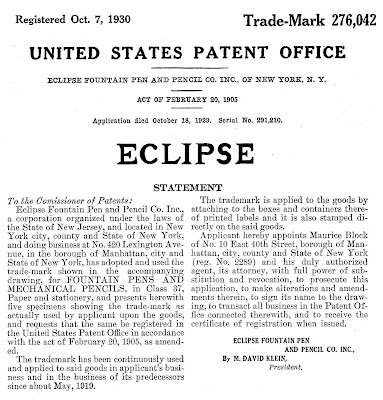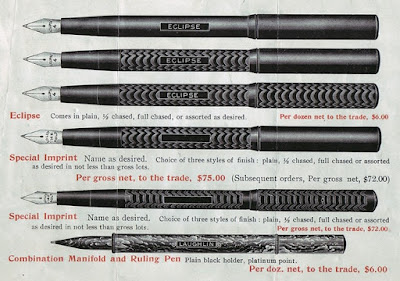This article has been included in The Leadhead's Pencil Blog Volume 7, now available here.
If you don't want the book but you enjoy the article, please consider supporting the Blog project here.
Loyal Knight Richard Keith has kept me on my toes lately. I made an offhand remark about the Eclipse Pen and Pencil Company in “Cleaning Out the Garage” about the founding of Eclipse: “In The Catalogue on page 50, I note that Marx Finstone established the Eclipse Pen Company in 1905," I wrote.
Richard emailed me within an hour after the post published to remind me that I had noted no such thing: in The Catalogue, I had reported 1903, not 1905. He questioned whether The Catalogue or the comment in my article was correct.
The better question would be when was Eclipse actually established: was it A. 1903, B. 1905, or C. none of the above? The correct answer is actually D . . . “none of the above, and none of the other ones you’ve heard, either.”
I retraced my steps and checked my sources for the 1903 date reported in The Catalogue. It came from a 2004 post on Fountain Pen Network written by George Kovalenko, who reported that Marx Finstone had founded Eclipse in San Francisco in 1903. “Some of this information was taken from various business directories and other pen history books, but most of it came from an article about the company written by Stephen Overbury. It was published in the British ‘Journal of the Writing Equipment Society’ in 1989, issue No. 24.,” George reported.
Overbury’s article was later republished in The Pennant in October, 1993, and he does in fact make that statement – but he doesn’t provide any sources for that conclusion. That presents a huge problem: according to another, equally reliable source, Marx Finstone wasn’t anywhere near San Francisco in 1903. In fact, he wasn’t even in the United States.
My thanks to Luiz Leite, who in response to my last Eclipse article posted images of “The Rise of Eclipse,” an article by John Roede published in the July, 2006 issue of Pen World (Volume 19, No. 6, page 28). Roede states that Marx Finstone emigrated to the United States from Poland at the age of 31 – in 1906.
In fact, I found no references at all to an Eclipse pen made in the United States between 1903 and 1906. The closest I found was an advertisement in the British publication The Practical Engineer on January 2, 1903:
According to this advertisement, the “sole makers” of this pen was the J. Waller & Company, in London. I found no evidence that this Eclipse pen was ever exported to or marketed in the United States.
In a 2010 post on Fountain Pen Network, “oldpenguy5" reported finding an Eclipse bearing a 1905 patent issued to Robert Hamilton, who he indicates was an officer in the Standard & Vulcanite Pen Company of Brooklyn. In American Writing Instrument Patents 1799-1910, I’ve listed several patents issued to Robert Hamilton, including number 781,649, issued February 7, 1905:
The patent was assigned one-half to John P. Lein, and none of Hamilton’s pen patents (nor any patents, for that matter) were assigned to the Standard & Vulcanite Pen Company.
I was able to confirm that Hamilton was secretary and treasurer of Standard & Vulcanite through a court case filed against the company by the Hardman Tire & Rubber Company, which had sued on an account for rubber material supplied to the company, for which Standard & Vulcanite refused to pay (Standard & Vulcanite found the material unsuitable for pen manufacture). On May 17, 1917, the case was tried and Hamilton testified that he had been in the fountain pen business for 39 years, but that he had been on the manufacturing side for the last 14 years.
(Note: the transcript of the trial, including many fascinating details about the manufacturing of pens from hard rubber, is preserved at https://books.google.com/books?id=RpIvMtS-fw4C&printsec=frontcover#v=onepage&q&f=false.)
From the testimony, it is clear that Standard & Vulcanite was making complete pens by 1914, including barrels, feeds, and nibs. Standard & Vulcanite’s attorneys counterclaimed against Hardman, alleging losses sustained from pens sold to its customers were later found to be defective. There was a scuffle over whether Standard’s lawyers had pled these damages with enough specificity, and the Court eventually threw out these claims . . . but before the Court did so, the names of a couple of Standard’s customers slipped into Hamilton’s testimony (page 119 of the appellate record). One was F.W. McIntosh, Standard’s Chicago representative, not relevant to the Eclipse story – the other, however, was the “Loughlin Manufacturing Company.”
Hamilton never testified for how long Standard had been supplying pens to “Loughlin,” and he never clarified whether this “Loughlin” was one and the same as the Laughlin Manufacturing Company in Detroit, Michigan. I believe it was, because that is a perfect link between an Eclipse-branded pen bearing Hamilton’s 1905 patent date and what happened next:
On September 21, 1906, the Topeka (Kansas) Daily Capital printed this advertisement for Edmonds Jewelers, in which Edmonds offered Eclipse fountain pens for sale which “were made up and labeled for the Eclipse Pen Co. which failed and left them on the hands of the Laughlin Mfg. Co., the manufacturers.”
Was Laughlin really the “manufacturer,” or were these pens supplied to Laughlin by Standard & Vulcanite, imprinted with the “Eclipse” name at the request of a shadowy Laughlin customer? I don’t think it’s a coincidence that Standard & Vulcanite was supplying Laughlin (or “Loughlin”) eight years later.
I did find one clue as to who Laughlin’s customer might have been, although it’s a longshot. On April 14, 1891, a man identified as L.A. Wright of Marshall, Michigan advertised for agents to sell an “Eclipse Fountain Pen” in the Detroit Free Press; Wright was in the right place using the right name, but that was fifteen years before Laughlin got stuck with unsold Eclipse pens – you would think if L.A. Wright was our man, some other evidence would survive to indicate that he was selling Eclipse pens between 1891 and 1906:
I don’t believe that Marx Finstone was behind this “Eclipse Pen Company” that failed in 1906. First, I believe Roede’s statement that Finstone emigrated to the United States from Poland in 1906, and that would be a remarkably short window of time within which Finstone would arrive in the United States, establish a pen company, and fail – all by September of that year.
Second, the supply chain doesn’t make sense: why would Finstone (in New York) order jobbed pens from Laughlin in Detroit, which in turn was supplied by Standard & Vulcanite in New Jersey, when he could have acquired them directly without having them shipped to the Midwest and then back again?
There’s also a third reason: the trademark registration for the word “Eclipse,” in plain old block text covering any shape in which these letters were rendered, wasn’t filed until 1929, by the Eclipse Fountain Pen and Pencil Co., Inc. – and the application states that the mark “has been continuously used and applied . . . in applicant’s business and in the business of its predecessors since about May, 1919.”
The word “continuously” leaves open the possibility that Finstone might have used the Eclipse name earlier, then abandoned it for a time before taking it back up in 1919; however, there is other evidence that prior to that date others were also using the name around the time Laughlin was scrambling to liquidate its unpaid-for stock. On April 19, 1906, the Los Angeles Evening Post-Record included an advertisement for Eclipse Fountain Pens in “heavy gold fill, fine and coarse points” for 97 cents. These don’t sound like the hard rubber pens Laughlin had on hand:
Meanwhile in Oklahoma City, Hartwell’s advertised Eclipse fountain pens “Especially made for Hartwells” in The Daily Oklahoman on December 12, 1906. These were Victorian-style dip pens rather than true fountain pens:
Laughlin may have been an unwilling liquidator of Eclipse pens at first, but apparently the company decided if it was selling the pens, it might as well appropriate the name, as well. In National City, California, W.S. Hill announced in the National City Star-News that he had “ordered another lot of ‘Eclipse’ fountain pens”:
In 1907, Eclipse fountain pens were advertised in the Pennsylvania-German, “manufactured and guaranteed by Laughlin Manufacturing Co.”
In 2010, Fountain Pen Network user Jkemp uploaded an image of a trade catalog page, showing Eclipse Fountain Pens offered for $.50 apiece to the trade, alongside Laughlin stylographic pens:
The name “Eclipse” might have evolved into a model name for Laughlin; in 1908, advertisements such as this one, in The Californian on August 14, 1908, offer “Laughlin Eclipse” pens:
Barrett Brothers in Camden New Jersey offered “The Electric Eclipse Fountain Pen” for $1 in the December 22, 1908 edition of the Courier Post. I’m not sure whether this is yet another penmaker using the name, or whether Laughlin briefly referred to them in this manner.
The latest connection I could find between Laughlin and the Eclipse name was an advertisement in the Student’s Herald (Manhattan, Kansas) on January 27, 1912. Although the ad doesn’t specify that the Eclipse was a Laughlin product, the two being offered side by side at the time could not have been coincidental:
Then there’s a curious advertisement, which ran in The Hartford Courant on May 12 and 13, 1911: an “Eclipse Fountain Pen Company” advertised pens for sale in the Catlin Building at 835 Main Street, Hartford:
Portions of The Catlin Building were leased out to a variety of tenants after its main occupant, The Glasgow Woolen Mills Company, vacated the building some time after 1903. The 1903 Hartford directory also lists a salesman named Arthur Louis Foster at that address, but it doesn’t indicate what or for whom Foster was selling. In 1906, “Hawkins, The Jeweler” advertised his wares in Room 15 of the building. I found no connection between either and this Eclipse Fountain Pen Company.
The timing of this Eclipse advertisement is odd, since The Hartford Courant had announced on January 19, 1911 that The Catlin Building was being razed by The Hartford National Bank to make way for the bank’s new building. Perhaps it was a clearance sale, since the tenants had been given notice that their building was coming down; on June 11, 1911, The Hartford Courant reported that demolition had started and the site would be “flat as a pancake within thirty days.” By January, 1912, construction of the new bank was underway, and the Catlin Building – along with this “Eclipse Fountain Pen Company” – were both gone.
Note: this story picks up tomorrow with Marx Finstone's entry into the pen business - see https://leadheadpencils.blogspot.com/2021/07/enter-marx-finstone.html.
















No comments:
Post a Comment